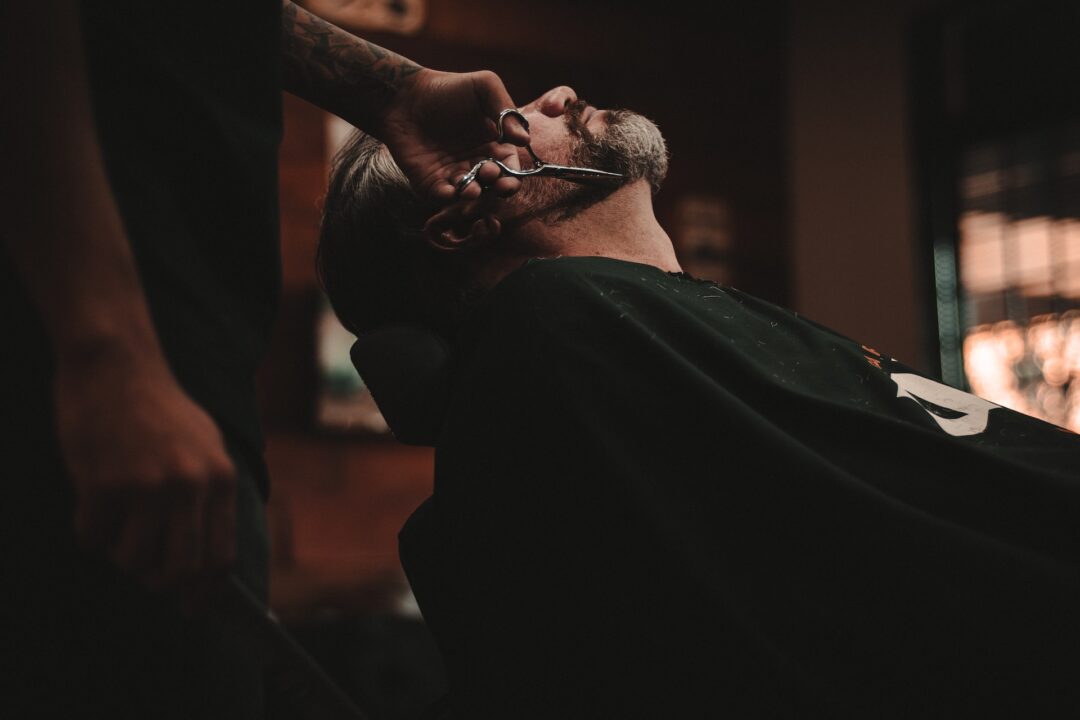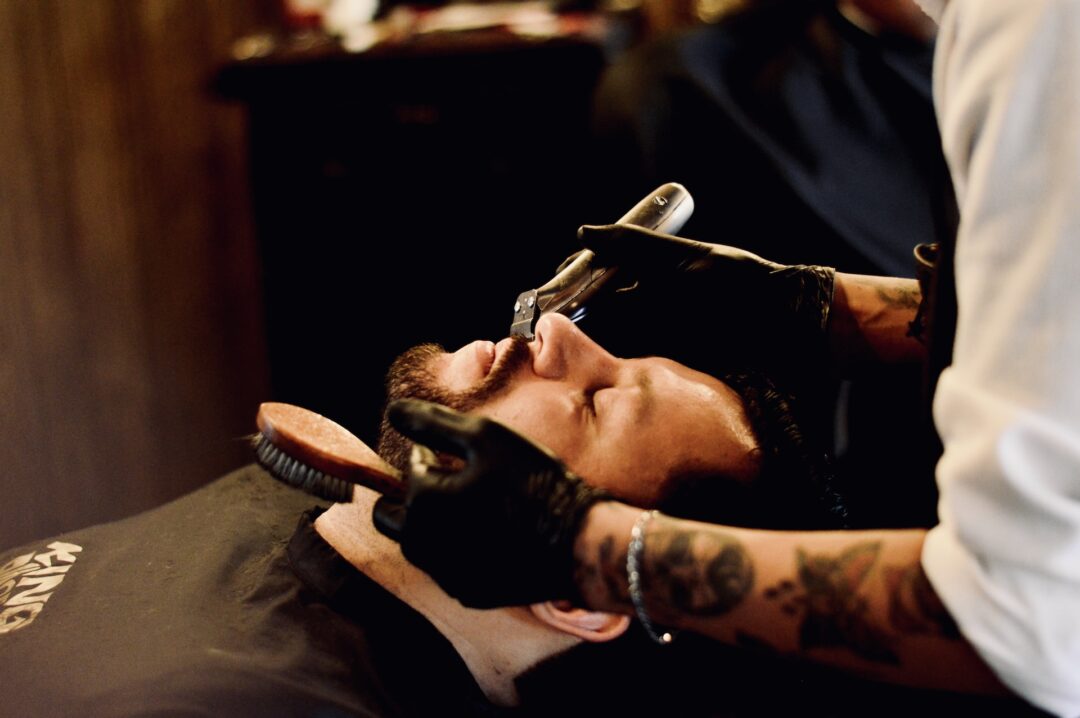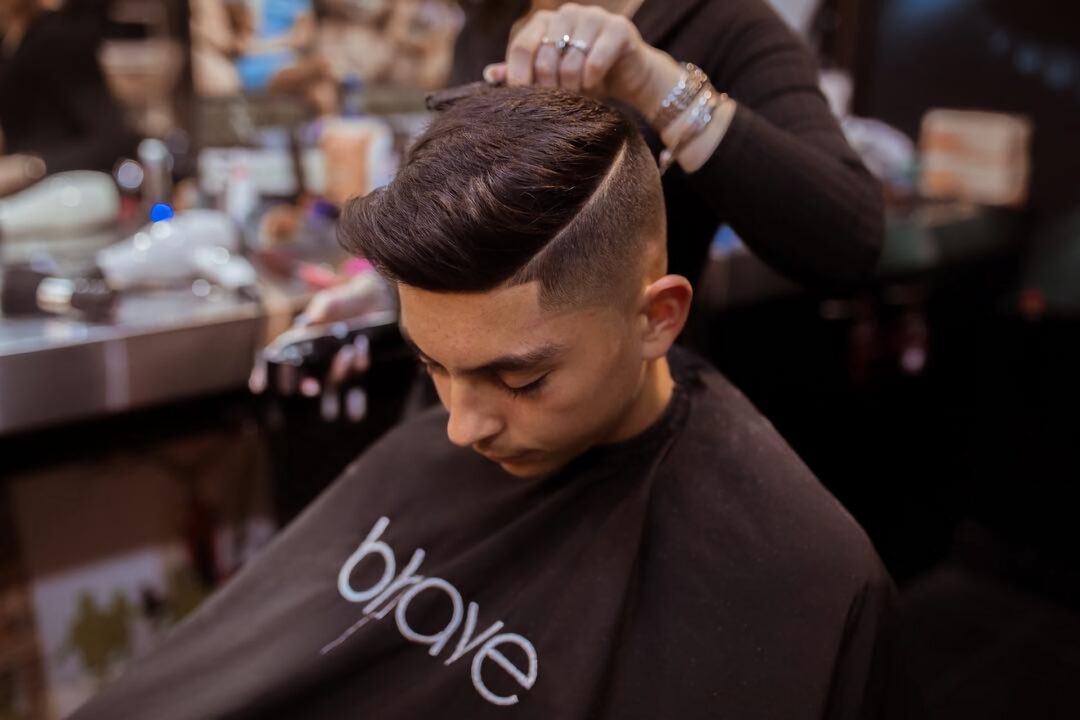In the 1940s and 1950s, the US military sported the fade, a style that later thrived in black and Hispanic barbershops. However, its transition into mainstream culture was marked in the 90s by figures like Will Smith in the Fresh Prince of Bel Air.
Once considered a bold look, potentially inappropriate for professional settings, the fade’s recent revival has ushered in a broader acceptance of such distinctive styles. The fade’s prominence has only escalated in recent times, as it has been embraced across various hair textures, with numerous individuals keen to incorporate it into diverse hairstyles. With variations like tapers, skin fades, and fades ranging from low to high, understanding the distinctions can be perplexing.
Thus, we present our comprehensive guide on whats a fade haircut is, explaining its nuances and offering a dose of inspiration.
What’s a Fade Haircut?
The fade haircut employs a distinctive trimming method that blends the hair until it seamlessly “fades” into the skin. This style often features lengthier hair on top, which progressively shortens towards the sides and back.
Often termed as the “military reg”, this style draws inspiration from the standard haircuts offered to servicemen. It’s a top-listed service in many barber shops due to its high demand. For instance, at Premier Barber Institute, our barbering students provide this particular cut in our student-operated barbershop and salon.
Executing this male-centric hairstyle often involves using a trimmer with various blade lengths to achieve the desired fade effect. It demands a significant level of expertise to handle the trimmer and ensure a seamless finish.
Types Of Fade Haircuts
Though rooted in a common technique, the men’s fade haircut has several distinct variations.
- LOW FADE: Here, only the bottom inch or so of hair on the back and sides is closely trimmed, with the fade commencing just above the ear. The crown typically retains longer hair, contrasting with the shorter sides and back;
- MEDIUM FADE: Initiating the fade several inches above the ear characterizes this style. The crown often has elongated hair. For a smoother gradient, barbers might begin with scissors for the upper layers and progressively trim as they approach the base;
- HIGH FADE: In the high fade variant, hair is trimmed most extensively, initiating just beneath the top of the head, reminiscent of traditional military cuts;
- POMPADOUR FADE: Merging two popular men’s styles, this look showcases a voluminous top reminiscent of a pompadour, where hair is thick, long, and styled upwards, often held with pomade. A distinct shaved part can further accentuate the transition to the faded sides;
- DROP FADE: This style features well-defined lines encircling the face and head for a polished appearance. The hair’s forefront typically displays a straight line across the brow, distinct sideburns, and a pronounced fade wrapping around the back;
- BEARD INTEGRATION: Fade haircuts aren’t limited to the scalp; they can transition seamlessly into facial hair. This method involves a fade descending from the hair’s sides to the sideburns and then ascends into the beard, creating a unified look;
- SKIN FADE: The most pronounced among fades, the skin fade sees hair being entirely shaven off towards its termination, resulting in a bald finish.
Fade Haircut Lengths
| Fade Haircut Length | Description |
| 1-2-3 Fade Haircut | A progressive blend transitioning smoothly from one length to another, often characterized by its graded nature. |
| 0-1 Fade Haircut | A seamless transition from skin (or zero length) to a slightly longer setting, providing a sharp contrast. |
| 2-1 Fade Haircut | Starting with a more pronounced length and tapering down to a shorter setting, offering a subtler but equally stylish appearance. |
| 2-3 Fade Haircut | Transitioning from a medium setting to a slightly longer length, giving a unique and distinctive look. |
The world of barbering brings with it a myriad of styles, but understanding the terminology is crucial to achieving the desired look. Among the popular terms, the 123 fade haircut is a progressive blend that transitions smoothly from one length to another, often characterized by its graded nature. Similarly, the 0-1 fade haircut offers a seamless transition from skin (or zero length) to a slightly longer setting, providing a sharp contrast. The 2-1 fade haircut, on the other hand, starts with a more pronounced length and tapers down to a shorter setting, offering a subtler but equally stylish appearance. Another intriguing variant is the 2-3 fade haircut, where the transition moves from a medium setting to a slightly longer length, giving a unique and distinctive look.
What’s a Bald Fade Haircut?

The world of hairstyling is vast, and amidst its expanse, the term “skin fade” frequently emerges, particularly when discussing the plethora of fade haircuts. In its essence, a skin fade is a meticulous process of trimming the hair on the sides until it seamlessly blends into the skin, resulting in a stark bald aesthetic. The technique often diverges from conventional practices. Instead of the traditional clipper, barbers utilize tools like the foil shaver or even a straight razor to ensure that ultra-smooth, skin-close finish.
While the skin fade undoubtedly makes a bold statement, it’s worth noting that not every fade must culminate in a skin-baring result. The quintessence of a fade is characterized by its gradient — the transition from one hair length to another. This doesn’t always have to pivot from a full head of hair to bare skin. Some might opt for a more subtle gradient, refraining from delving into the realm of the 0 guard length, instead specifying a particular guard length for a milder fade. Among its many variants, the skin fade is the most pronounced, showcasing a conspicuous journey from a bald foundation, transitioning possibly to a 0.5, and culminating in a denser 2 at the higher reaches of the sides. On the contrary, a transition between a guard number 2 to 3 might manifest as a softer contrast, with visibility often contingent on individual hair characteristics such as color and thickness.
How Can You Master the Art of the Fade?
The fade, with its myriad of styles and variations, is a cornerstone of barber education.
In their professional journey, aspiring barbers delve deep into various aspects of men’s grooming, such as:
- A Deep Dive into Haircut Trends: Aspiring barbers not only familiarize themselves with timeless classics but also stay abreast of contemporary and evolving men’s hair trends to meet diverse client preferences;
- Hair Treatments and Color Mastery: Beyond basic cutting techniques, there’s a world of treatments and colors to explore. A skilled barber knows how to enhance a look with the right shade or hair treatment, ensuring each client leaves the chair satisfied;
- The Science of Beard and Shave: The face is a canvas, and a beard or clean shave can significantly alter its appearance. By understanding the nuances of beard grooming and the precision of shaving, barbers can offer a holistic grooming experience;
- Perming and Relaxation Techniques: With the rising demand for varied textures and styles, it’s crucial for barbers to be adept at perming and hair relaxation treatments, allowing clients to switch up their looks effortlessly;
- Hygiene and Bacteriology: A barber’s role isn’t limited to styling alone. Ensuring a clean and sterile environment is paramount. A solid understanding of bacteriology ensures that every client’s experience is not only stylish but also safe;
- Tech and Tool Proficiency: The tools of the trade play a pivotal role in delivering perfect cuts. From becoming adept with electrical tools to mastering the timeless technique of straight razoring, technical prowess is just as crucial as artistic flair.
In conclusion, while the fade remains a hallmark of barbering expertise, the journey to mastery in this profession involves a harmonious blend of tradition, innovation, technique, and continuous learning. Every aspiring barber is on a mission to perfect their craft, ensuring every client walks away feeling confident and looking their best.
How Should You Request a Fade Hairstyle?
Navigating the world of fades can be intricate, so here’s a step-by-step guide to ensure you communicate effectively with your barber:
- Determine the Fade’s Height: Decide between low, mid, high, or taper. Discuss with your barber which suits your face shape, desired style, and your daily routine. Remember, varying fade heights complement different face shapes and hairdos;
- Decide the Top Style: A fade predominantly shapes the back and sides; it doesn’t stand alone. Consider the top hairstyle you desire. For some visual cues, scroll down for inspiration;
- Select the Fade’s Depth: The fade defines a style, not a specific length. How deep do you envision your fade? Options span from a skin fade (totally bald) to varying clipper lengths like 0, 0.5, 1, 1.5, 2, 2.5, 3. If in doubt, opt for a longer start like a number 2 and ask your barber to gradually decrease the length. It’s prudent to begin conservatively than to go exceedingly short and regret. Notify your barber if you’re hesitant about the desired length. They can provide a sample section for clarity. Avoid making your barber redo their work by suddenly desiring a shorter fade after completion;
- Leverage Visual Aids: Feeling overwhelmed? Simplify the process by presenting a clear image or a collection of images that resonate with your desired look. Visuals ensure you and your barber align in understanding, preventing potential miscommunications;
The Comprehensive Guide to Faded Hairstyles

- Crop Haircut With Fade: Opt for a crop featuring a longer or shorter fringe, based on your facial structure and hairline position. Ensure your barber infuses ample texture for that rugged appearance;
- This hairstyle typically complements a low to mid skin fade. For styling, employ the Regal Gentleman Matte Clay to accentuate the texture and achieve a matte, natural look;
- Pompadour With Fade: The pompadour fade blends elegance with a modern touch. Ideal for those who prefer substantial length on top while maintaining short sides and back. Typically, it’s paired with taper, low, and mid fades, steering clear from overly dramatic high fades. Given its voluminous top, it’s best not to go too drastic. Opt for a longer fade instead of a skin-close shave. To achieve the desired look, consider using a product like the Regal Gentleman Texture Paste;
- Modern Buzz Cut With Fade: The contemporary buzz cut distinguishes itself with a faded back and sides and a slightly elongated top, deviating from the uniform length of traditional buzz cuts. This variation introduces a stylistic element, ensuring it appears professionally done rather than a home DIY. Fades for this style usually range from mid to high, often showcasing an ultra-short skin or #0 fade on the back and sides, progressing to a #1 to #5 length on top. The best part? Zero styling needed – it’s a wash-and-wear hairstyle!;
- Faded Side Part: A timeless favorite, the side parting has graced the heads of many. For a gentler appearance, pair it with a low or mid fade. But, if you’re aiming for a bolder statement, a high skin fade complements perfectly. This adaptable style can accommodate any length on the back and sides. To bring out its charm, style with a pomade offering medium to high shine, such as the Regal Gentleman Pomade;
- Faded Quiff Style: The quiff remains versatile, suitable for varied lengths. Recently, we’ve noticed a trend towards shorter, textured quiffs. However, the traditional quiff boasts a medium-long appearance. For an edgier appeal, keep the front longer and infuse texture for a tousled outcome. Depending on the top’s texture and length, the fade’s height will vary. Shorter tops often accompany higher fades, while longer tops are best paired with low to mid fades. For styling, consider the Regal Gentleman Matte Clay. It ensures a matte finish and offers both durability and flexibility, making it ideal for a textured quiff;
- Modern Faded Undercut: Transitioning from the starkly disconnected look, the contemporary faded undercut incorporates a smoother blend. You’ll typically find this style combined with mid to high fades. The choice of product for styling will be influenced by your desired shine level, but for flexibility, the Regal Gentleman Texture Paste stands out;
- Curly Fade With Undercut: Tailored for those with curly locks, this style mirrors the faded undercut but is accentuated by the curls. Often, the hair cascades down, mimicking a fringe, complemented by mid-level faded sides. For styling, begin with the Regal Gentleman Salt Spray on damp tresses. Seal the look with a leave-in conditioner or a moisturizing product to nurture and accentuate your curls.
FAQ
Q: How do I choose the right fade haircut for me?
A: The choice depends on your personal style, face shape, and hair texture. Consulting with a skilled barber can help you select the best option.
Q: What’s the difference between a fade and a taper?
A: A fade has a more gradual transition, while a taper has a more defined, deliberate change in length. Fades are typically shorter at the bottom and taper to a longer length higher up.
Q: Can women have fade haircuts too?
A: Absolutely! Fade haircuts are not limited to men. Many women also embrace fade hairstyles, adding a unique and edgy touch to their look.
Q: How should I maintain a fade haircut?
Maintaining a fade involves regular trips to the barber for touch-ups. You can also use quality hair products to style and keep the hair looking sharp.
Q: Are fade haircuts suitable for all hair types?
A: Fade haircuts can work with various hair types, but some may require additional styling products or techniques to achieve the desired look.
Q: Is it necessary to visit a professional barber for a fade haircut?
A: While it’s recommended to visit a skilled barber for the best results, experienced individuals can attempt a fade haircut at home with the right tools and guidance.
Q: How do I ask my barber for a fade haircut?
A: Be specific about the type of fade (low, mid, high, skin) and the transition point you want. Showing pictures or using clear terminology will help your barber understand your preferences.
Q: Can I combine a fade with other hairstyles?
A: Yes, fade haircuts can be combined with various styles, such as pompadours, quiffs, undercuts, and more to create a unique, personalized look.
Q: How long does a fade haircut typically last before needing a touch-up?
A: The duration varies based on how fast your hair grows and the specific type of fade. Generally, you’ll need a touch-up every 2 to 4 weeks.
Q: Are there any specific products recommended for styling a fade haircut?
A: Products like pomades, gels, and hair clays can help style and maintain a fade haircut, depending on your desired finish.
Q: Can fade haircuts be casual and formal?
A: Yes, fade haircuts are versatile and can be styled for both casual and formal occasions, making them a popular choice for various settings.
Conclusion
The fade haircut, a testament to the evolution of men’s hairstyles, has firmly established itself as a timeless and versatile choice. Rooted in historical traditions from the military to mainstream media icons, it has transcended eras, cultures, and hair textures. With a plethora of variations and techniques, from low to high fades and integration into beard styling, the fade caters to a broad spectrum of aesthetic preferences. Its adaptability makes it suitable for various face shapes, hair types, and personal styles. As with any hairstyle, communication with your barber is paramount to achieve the desired outcome. Whether you’re considering a bold skin fade or a subtler gradient, understanding the nuances of the fade haircut ensures a stylish and personalized look every time.



